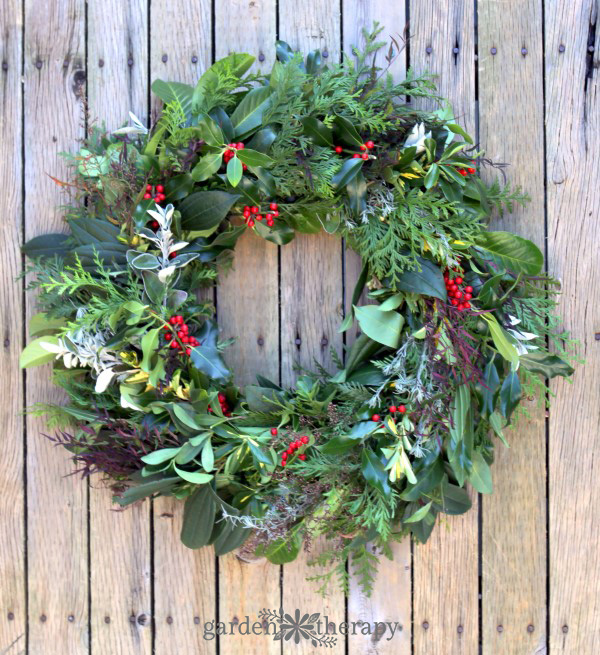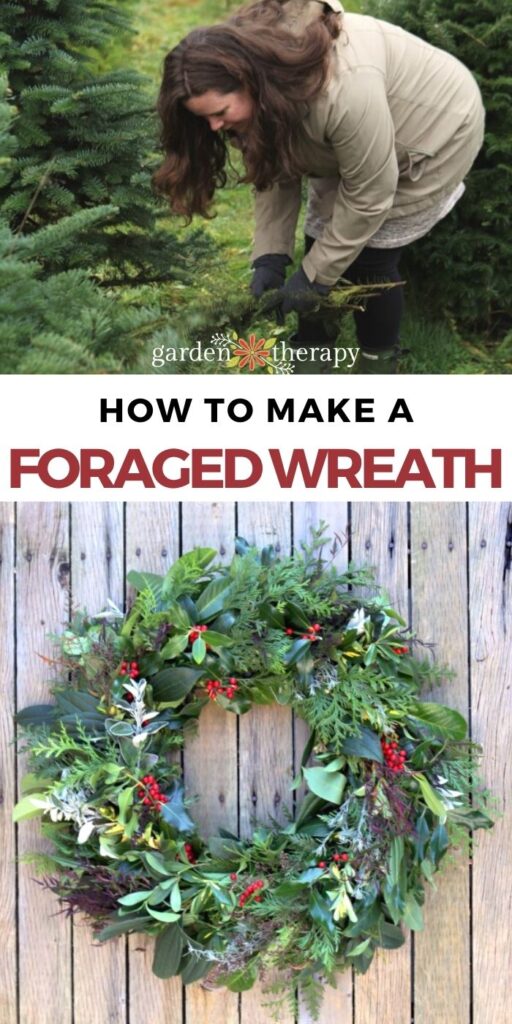Wreaths made from fresh foraged materials are a wonderful way to make an entrance look welcoming or to jazz up a drab fence or garden shed. Here’s how to make a wreath entirely from foraged materials! Half the fun of this kind of wreath making is supply “shopping” in your own garden!

This year will be a very strange but exciting Christmas for me as it will be my first one in my new house! Typically at this time, I’m out taking clippings from my backyard for crafting and decorating my house.
But this year is looking a little different. My garden at the moment is just a simple turfed front yard with containers I filled from my previous garden. So I’m lacking on the natural supply front from my garden!
While I’ve foraged many times to make a natural wreath, this year, I’ll gather all my supplies from the great outdoors rather than my personal garden. And this isn’t just for my Christmas wreath! I make them pretty well all year round.
You might make a personalized one for every season too. Not to mention Halloween, Easter, your birthday (and your dog’s birthday)…there are so many beautiful variations to try that you’ll want to make a new wreath for every occasion you can think of.
Learning how to make a wreath isn’t as difficult as you may think. Let me lead you through gathering supplies, creation basics, and plenty of inspiration to get started on your DIY wreath!
This post will cover…


Foraging for Natural Elements
Whatever you choose to add to your wreath, take time to enjoy the process of collecting your materials out in nature. As you pick and choose which elements to harvest and add to your wreath, enjoy mindfully walking through nature and looking for the beautiful plant life that catches your eye.
If you are collecting materials from your own backyard and garden, try to look at things from a new perspective. You may find a ton of beauty in something you have never paid much attention to.
Seed heads, evergreen branches, and even some vegetables make lovely additions. Take a slow walk around your backyard, collecting everything that tickles your fancy.
You can also forage in nature areas away from home, just be sure to choose a spot where you are allowed to take things. Do a little research on the local ecosystem before setting out on a foraging expedition to make sure you know which plants are appropriate to harvest from.
Find out what plants are endangered and leave those ones be. It’s a good rule of thumb to always take just a little of any plant (a branch here, a seed head there) so as not to disturb the natural balance of the wild.
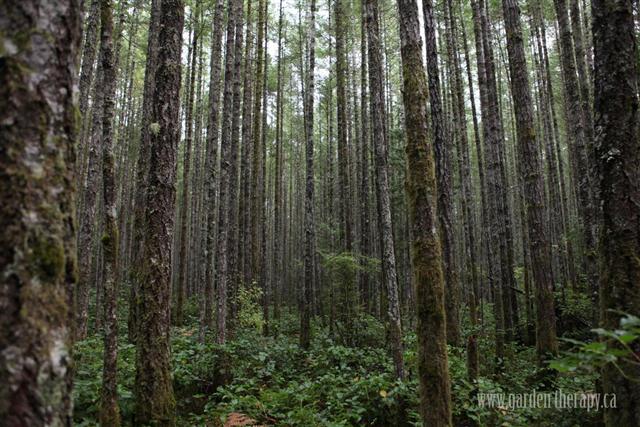

How to Make a Wreath
Start by following these step-by-step instructions on how to make a fresh wreath using any evergreen branches you have on hand. You can use all the same evergreens or mix in a variety of plants.
If you prefer to watch, follow my video to see how I made my most recent wreath!
Once you have this technique down, you can dress it up with basically anything that you have on hand. Scroll down for some ideas, and let your imagination run wild! The possibilities are endless.
Fresh Foraged Wreath Inspiration
Now, check out these creative ideas for inspiration on how to customize your foraged wreath and let your imagination run wild.
Vary the Greenery
I love the look of this fresh wreath that is decked out with many different types of greenery. The various colours and textures give visual interest while keeping the overall design cohesive. See this post for information on the best greenery to use in decor.


Make a Pinecone Wreath
Wreaths can also be beautiful with no greenery at all! This bleached pinecone wreath is rustic with a soft, modern feel. Adding just a few pinecones to an evergreen wreath can also be fun for variation in texture and colour.
Even if you don’t live in an area with pinecones, you can still make this natural wreath! Just purchase your pinecones online and start crafting.
Go for Traditional Holly
A traditional wreath made entirely with holly is an old standby for a reason. Holly wreaths give any home a touch of classic holiday decor.
Try an Edible Kitchen Wreath
This pretty culinary wreath is decorated entirely with herbs. This is a great way to attractively dry herbs and to have them on hand for cooking. Just snip a few sprigs off the wreath as you need them. Plus, it makes your home smell fantastic.
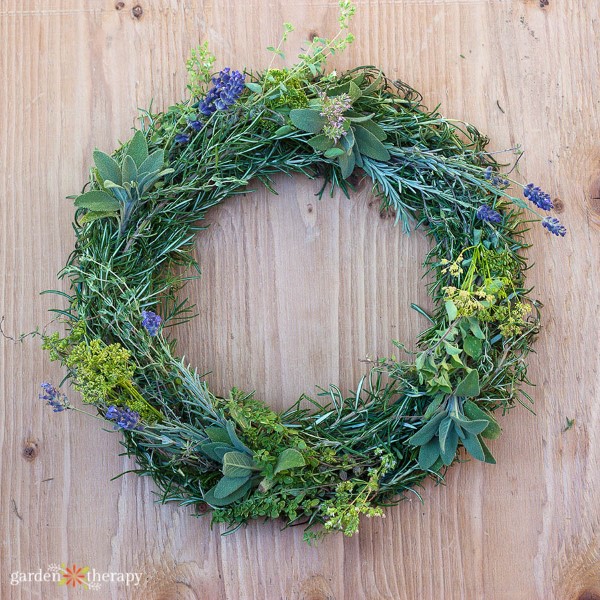

Choose Scented Plants for Aromatherapy
Choose plants that have a strong, pleasing scent to make a DIY wreath that smells as good as it looks! The scent will make your home feel welcoming and give you a little lift every time you walk by.
I made this lovely scented wreath using eucalyptus and incense cedar, but some other fragrant evergreens you could try are juniper, pine, and balsam.


Plant a Living Wreath with Succulents
You can learn how to make a natural wreath that grows by planting succulents in a grapevine wreath form. Learn to make your own grapevine wreath here.
Use a Bit of Everything
You can take bits of greenery, berries, hydrangeas, pinecones, and anything else you can dream up to create this lovely everything wreath. It can be made in countless different ways depending on what you have available in your yard or neighbourhood.
Welcome Fall with Gourds
Here’s an excellent example of a fresh wreath perfect for the autumnal season. This charming gourd wreath is the perfect way to decorate for fall and celebrate the harvest.
Use Hydrangeas
This hydrangea wreath looks elegant and at home at any time of year. See this post for instructions on constructing it, plus tips for making it last.


Frequently Asked Questions About DIY Wreaths
When we think of learning how to make a wreath, we may automatically conjure up visions of the holiday season. However, wreaths are not just for the holiday. They are a beautiful way to decorate in any season!
They bring the beauty and fragrance of the outdoors in and are an enjoyable and meditative project to make. Plus, there are so many possibilities other than just greenery! Dried or fresh flowers, herbs, seed pods, berries, feathers, pinecones, and even small gourds can be added to beautiful fresh wreaths for a unique statement piece.
You can also embellish your fresh wreath with other bits and pieces you might have lying around your craft room (think floaty gossamer ribbons or burlap bows) to add an interesting textural contrast to the fresh greens and flowers on the base of your wreath.
I’m lucky to live in the Pacific Northwest, where I can access tons of amazing greenery throughout the year. Some of my favourite pieces of greenery include cedar, pine, spruce, fir, magnolia leaves, holly, viburnum, and pinecones. Check out this list of the best greenery for decorating for more ideas.
A natural wreath can last for months, depending on the temperature. In Vancouver, my fresh wreaths made in December lasted well until March when hung on my front door. Usually, I take them down not because they don’t look good anymore but because they’re not in season!
Fresh wreaths in warmer climates may not last as long. Wreaths hung indoors will also dry out faster. In warm conditions, you can expect your wreath to last for a couple of weeks before it begins to look too dry.
When foraging for your wreath, immediately put cut stems in a bucket of water. This allows them to soak up as much water as possible before being put on the wreath. You can allow them to sit in the water for a few hours.
When it’s hung, mist the wreath with water. Aim at the back of the wreath where the cut stems are. The plants can soak up some moisture, even while hanging up.
For my wreaths, I leave them alone with no preservatives or spraying, and they last for months. If you live somewhere cool and hang your wreath outside, you may not need to do any work either.
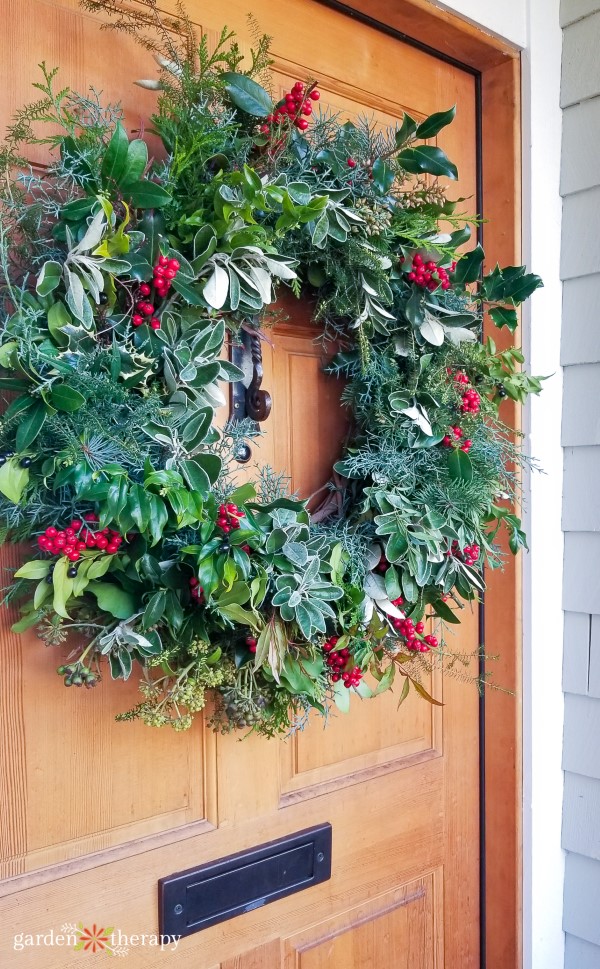

These are just a few ideas that you can use to make creative wreaths, but once you know the basics of wreath making you can really come up with endless gorgeous designs. Feel free to share photos of your own creations!
More Garden-Inspired Decor



